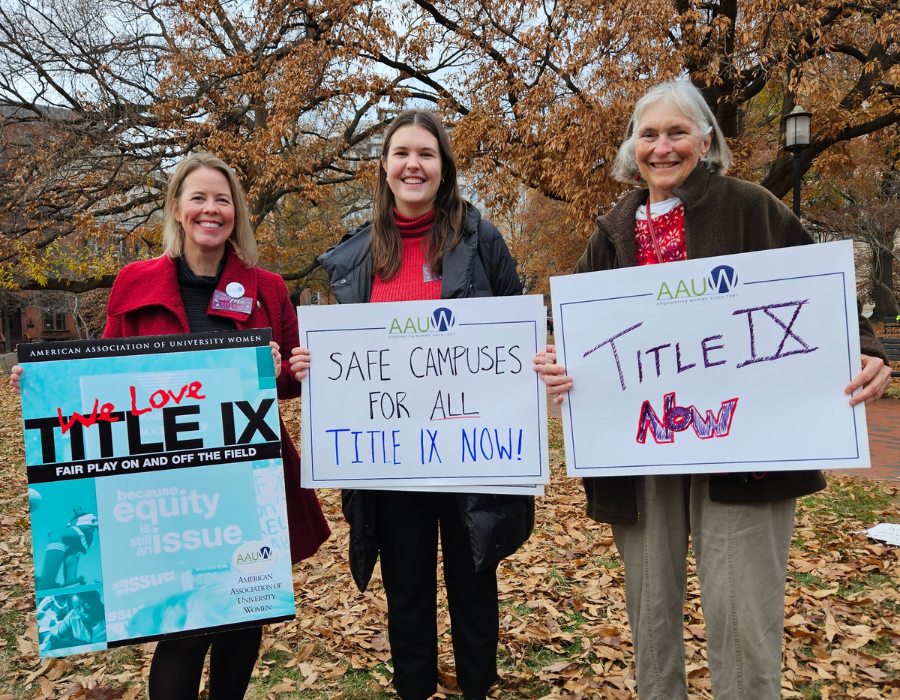Education
Education powers equity. AAUW removes barriers so women and girls can access learning, unlock opportunity, and lead in their communities and beyond.
Education is a powerful catalyst for opportunity — but persistent barriers continue to hold women and girls back. From civil rights rollbacks and rising tuition to disproportionate debt and campus discrimination, systemic obstacles threaten access and equity at every level. AAUW works to remove those barriers and advance inclusive, affordable, and equitable education, because when women learn without obstacles, entire communities thrive.
But deep disparities persist:
- Student Debt and Affordability Challenges – Women hold nearly two-thirds of all student loan debt, with Black women carrying the highest average balances, compounding financial insecurity. At the same time, congressional proposals to cut access to Pell Grants and eliminate Graduate PLUS loans threaten to make graduate education even less attainable, especially for women and students of color.
- Escalating Attacks on Civil Rights – From assaults on Title IX and Title IV protections to sweeping efforts to dismantle the U.S. Department of Education, these attacks threaten to roll back decades of progress and leave women and girls more vulnerable to discrimination and harassment in schools and on campuses.
- Underrepresentation in STEM and Leadership Fields – Women, especially women of color, remain significantly underrepresented in STEM disciplines. Women earn just 22% of engineering doctorates, limiting access to high-growth, high-paying careers.
- Underrepresentation in Academic Leadership – Women — particularly women of color — also remain underrepresented in faculty and administrative leadership roles. They make up only 32% of full professors, limiting decision-making power and mentorship opportunities.
- Non-Tuition Barriers – Challenges including affordable childcare, support for pregnant and parenting students, and access to reproductive healthcare disproportionately impact women pursuing higher education. Latina students, in particular, face layered challenges — with 23% parenting while in college.
AAUW is committed to breaking down these barriers through robust advocacy, targeted funding, and steadfast support for the rights of all women and girls to pursue their education free from discrimination and financial hardship.
Explore the Issue
Higher Education
Systemic barriers — from campus harassment and student debt to limited grant aid and childcare challenges — block women’s progress. AAUW advocates for affordable, inclusive higher education and policies that remove obstacles so women can complete degrees and advance their careers.
Civil Rights in Schools
AAUW advocates for strong enforcement and continued strengthening of civil rights laws in education — including Title IX, Title VI, Section 504 of the Rehabilitation Act, and other statutes — to ensure all students can learn free from discrimination, harassment, and bias.
Inclusive Curriculum
AAUW champions historically accurate, inclusive curriculum grounded in scientific consensus. We oppose censorship and affirm Title IX protections from discrimination based on sexual orientation and gender identity, ensuring all students see themselves reflected in what they learn.
Science, Technology, Engineering, and Math (STEM)
Girls and women remain underrepresented in high-demand STEM fields. AAUW supports programs and policies to close gender gaps, expand pathways, and help women thrive in technical and scientific careers.
Public Education
AAUW advocates for strong, equitable public K–12 schools as the foundation of opportunity. We oppose diverting public funds to nonpublic and charter schools without civil rights protections and support closing learning gaps that disproportionately harm underserved students.
AAUW in Action

Investing in Women: Fellowships & Grants
Since 1888, AAUW has invested millions each year in women’s graduate education through flagship Fellowships & Grants—from American and International Fellowships to Career Development and Selected Professions awards—while Community Action Grants fund local projects like robotics clubs and coding camps that spark girls’ interest in STEM.

Shaping Public Policy
From Pell Grants and student‑loan reform to campus safety and Title IX enforcement, AAUW members drive policy solutions that promote gender fairness, equity, diversity and inclusivity in education. We convene and participate in coalitions such as National Coalition for Women and Girls in Education, Pregnant & Parenting Students, College Not Cuts, and the Leadership Conference on Civil & Human Rights Education Task Force to expand opportunity and protect students’ rights.

Standing Up in Court
Through our Legal Advocacy Fund, AAUW supports individuals challenging sex discrimination in education and the workplace—leveraging the courts to set precedent and secure systemic change.
Take Action
Get involved in advancing gender equity. Whether you stay informed, contribute, or share our mission with others, your engagement helps support equity for women and girls.
Sign up for news & updates
Stay connected with AAUW and join our mission to advance gender equity. Sign up for our updates to receive the latest news, events, and opportunities to make an impact in the lives of women and girls.
